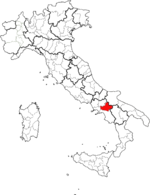Province of Avellino
| Nation | |
| Region | Campania |
| Capital(s) | Avellino |
| Area | 2,792 km2 |
| Population (2010) | 429,073 |
| Density | 154 inhab./km2 |
| Comuni | 119 |
| Vehicle Registration | AV |
| Postal Code | 83010-83018, 83020-83032, 83034-83054, 83056-83059 |
| Telephone Prefix | 081, 082, 0824, 0825, 0827, 0835 |
| ISTAT | 064 |
| President | Alberta De Simone |
 |
|
| Map highlighting the location of the province of Avellino in Italy | |
The Province of Avellino (Italian: Provincia di Avellino) is a province in the Campania region of Italy. The area is typified by many small towns and villages scattered across the province; in fact only two towns have a population over 20,000; its capital city Avellino and Ariano Irpino.
Contents |
Geography
It has an area of 2,792 km², and a total population of 429,178 (2001). There are 119 comuni (singluar: comune) in the province,[1] see Comuni of the Province of Avellino.
History
In the ancient Kingdom of Naples the province roughly corresponded to the Principato Ultra, though some places were included in Capitanata or Principato Citra. It is an inner province, unconnected to the sea. The ancient name of the area was "Hirpinia" (modern Italian: Irpinia), derived from the Oscan "hirpus", wolf, an animal that is still present in the territory though in greatly reduced numbers. The province has great environmental interest including the Regional Parks Monti Picentini and Partenio, together with two WWF sites, Valle della Caccia in Senerchia and the area around the Ofanto dam in Conza della Campania.
Avellino was known for its royal guards during the medieval and Roman times.
Gastronomy
Typical products are hazelnuts (one third of the whole Italian production), the chestnut of Montella, the renowned wines Aglianico, Taurasi, Greco and Fiano, cherries, cheeses (as the caciocavallo of Montella), the black truffle of Bagnoli Irpino.
Tourism
The main tourist destinations are the Sanctuaries of Montevergine (over 300,000 visitors per year) and of San Gerardo a Maiella, the ski resort of Laceno, the archeological areas of Avella and Aeclanum, the Lancellotti castle, the roman ruines of Abellinum and the early Christian Basilica in Prata.
See also
- Avellino corneal dystrophy
References
External links
- Provincia di Avellino homepage (Italian)
- Lupi Emigranti (Italian) (English) founded by Frigento(AV)'s students and workers in order to get in touch with Province of Avellino's emigrants
|
|||||||||||
|
|||||